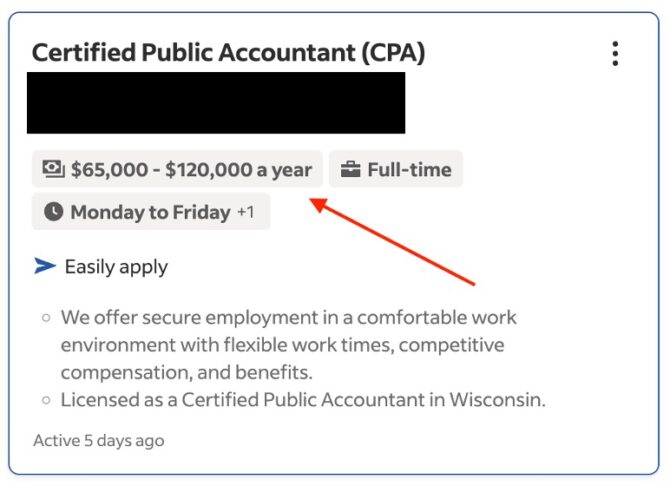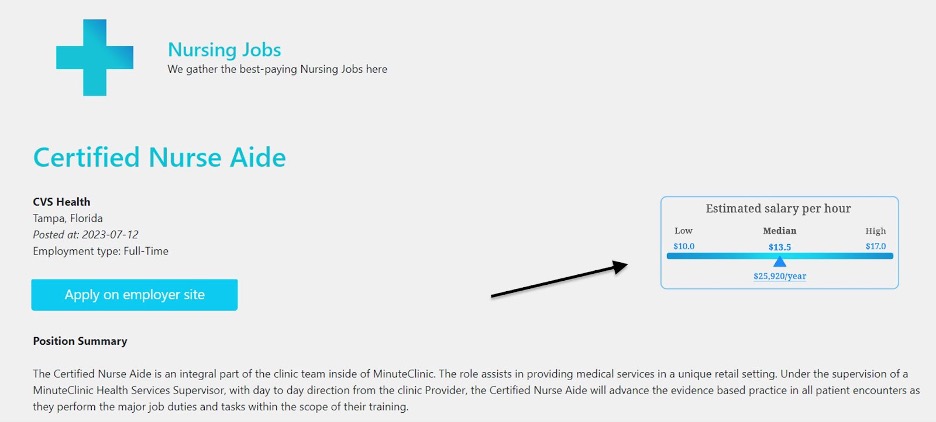
Aspen Tech Labs Doubles Down on Salary Transparency with New Salary Widget Product
From viral TikTok accounts dedicated to asking professionals what they make to new pieces of legislation moving through the courts, salary transparency is top of mind for many. And we’re seeing it emphasized more in job listings.
[Related: Aspen Tech Labs’ Q2 2023 Jobs Report]
But there’s still room to improve the job search process for candidates. And until every job listing includes compensation data, candidates will have to do a fair bit of guesswork when finding employers’ salary ranges.

Plenty of job boards have created salary estimators to compensate for missing wage information. But as nearly every job seeker today can attest, these estimates often display a wide range (Figure 1).
It’s possible that job boards like Indeed deliberately offer poor estimates as a bargaining chip of sorts: to encourage employers to post real salary information. But the broad salary estimates still leave candidates in the dark (in the same way offering no wage information does).
So to help job seekers find a role aligned with their compensation requirements, we developed a new salary transparency tool to provide more accurate wage estimates: our Salary Widget. Keep reading to learn what it is and how it differs from our Wage Benchmarking Tool.
What Is the Salary Widget? 3 Use Cases
Our new Salary Widget lets job seekers see estimated salary information for the job titles they search on recruitment sites and job boards (Figure 2). And because these estimates are pulled from the more than nine million real-time, active, organic listings in our jobs database, users get more accurate estimates than they can get elsewhere.

How does that benefit job boards and recruitment firms? It helps keep job seekers – who want salary information – on their sites. Adding the Salary Widget is simple, too. It’s available via Javascript code or API.
Here are three ways job seekers and job board leaders can benefit from this salary transparency tool.
Use case #1: A worker wants to know the salary differences between two cities
Let’s say an accountant is considering a move from Milwaukee to New York City. But before planning in earnest, they want to see how their compensation may change between where they currently live and where they may end up living. So the accountant uses the Salary Widget and searches “Accountant in New York City” to view the estimated salary ranges for accountants in New York City.
This tool lets the accountant compare the salary estimates with what they currently make and, ultimately, helps them decide whether to relocate or stay in Milwaukee.
Use case #2: A job board wants to improve their site’s UX and boost their bottom line
Picture this: you’re the Chief Revenue Officer of a leading or niche job board. Your cost-per-click (CPC) and cost-per-application (CPA) revenue has been dropping. You’re not sure why, so you check out your competitors’ sites. They offer similar features, but they also include salary estimates, which help improve the user experience (UX).
You know how important wage information is to job seekers. And after some research, you realize it’s also important to the Google for Jobs algorithm. So you add the Salary Widget. Gradually, your revenue climbs back. Your job board’s UX has improved, and the people who visit your site are clearly sticking around longer.
Use case #3: An early-career candidate wants to know salaries for entry-level roles
Navigating the job market is never easy. But it’s particularly difficult when you haven’t done it for long. Salary estimation tools can help early-career professionals determine their worth to companies (what’s a fair starting salary?) and find roles that may offer fair compensation.
The Salary Widget lets candidates do this compensation research and apply for relevant jobs in the same place: a job board.
Salary Widget vs. Wage Benchmarking Tool: Salary Transparency for Job Seekers and Employers
For existing customers and those familiar with our salary transparency tools, you may be wondering about the differences between our Salary Widget and Wage Benchmarking Tool. To address those questions, we’ve broken down each product in the table below.
| HOW IT WORKS | SALARY WIDGET | WAGE BENCHMARKING TOOL |
| What is this product? | This widget lets job seekers search job titles and quickly view relevant estimated salary information. For example, if a candidate searches “Warehouse Worker in Atlanta,” the salary widget will display an estimated salary range for warehouse workers in Atlanta. And you can place it anywhere on your platform, whether via API or a Javascript code snippet. | This tool lets employers compare wages from real-time job listings and filter the data in various ways (industry, geography, title, etc.). For example, if you run an IT firm and want to compare your salary for product managers with your citywide average, you’d use this tool. |
| Who uses this product? | And you can place it anywhere on your platform, whether via API or a Javascript code snippet. Job seekers see the widget’s outputs. Job board and recruitment firm leaders install and manage it. | Employers Recruitment agencies Job board owners Compliance bodies Journalists and researchers |
| What information does this product provide? | Current salary estimates based on a user’s query, e.g., “Accountant in Milwaukee.” The tool offers a low (10th percentile), median, and high (90th percentile) salary figure. | Real-time, or historical, salary data filtered by… Geography Employer Job Title Experience level Industry |
| What's the look and feel of the product? | This widget can be… An interactive sidebar alongside a job board’s search bar OR A separate page on a job advertising site. | Users can view this tool from a custom dashboard built with Google Looker. With it, you get data visualizations as well as the ability to sort interactive data tables. |
| Where does the salary data come from? | JobsIndex, our database of more than 9M global, organic job listings. | JobsIndex, our database of more than 9M global, organic job listings. |
| How often is the data updated? | Daily. This helps ensure every piece of compensation data is pulled from live, unfilled listings. | Daily. This helps ensure every piece of compensation data is pulled from live, unfilled listings. |
| Can users customize the data they see? | Yes. We always offer opportunities to let businesses customize the data – though there are certain limitations depending on complexity (if you have questions, please contact us). | Yes. While we use data from our JobsIndex, we can also scrape additional jobs with listings that fit your parameters. |
| Can users customize the branding? | Yes. Our widget includes two appearance options: 1. Standard. This free design format retains Aspen Tech Labs’ branding and includes the language “powered by jobmarkettoday.com. 2. Custom. This premium offering lets you control the UI of the widget (color, logos, typeface, etc.) and effectively customize it to fit whatever brand you want. | Yes. Though this dashboard is for internal use, we can easily adjust the appearance of it to fit your existing brand. |
Still not entirely sure what you need – whether it’s our Salary Widget (test a version here), Wage Benchmarking Tool, or both? We’re happy to speak with you and offer our expertise.
Keep Job Seekers On Your Site with Compensation Data
Job seekers want salary information in job listings. Seventy-five percent said they’re more likely to apply for a job when salary data is included. It’s that simple. Every job board leader, recruitment firm, and employer that wants to shorten hiring processes should make salary transparency a priority.
Another benefit of increased salary transparency? Pay equity. (Relatedly, the gender wage gap is now the smallest it’s been since the US began measuring it in 1979 – hooray!)
Our Salary Widget doesn’t just give job seekers the information they want before clicking apply; it also gives them a reason to keep searching on your site.
Want to learn more about our salary data or how you can add the Salary Widget to your site today? Reach out for a personalized demo!